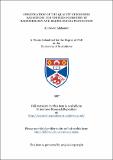Files in this item
Specification of the quality of ionising radiations for unified dosimetry in radiobiology and radiological protection
Item metadata
| dc.contributor.advisor | Watt, D. E. | |
| dc.contributor.author | Alkharam, Ali Salem | |
| dc.coverage.spatial | 303 p. | en_US |
| dc.date.accessioned | 2018-05-17T08:46:13Z | |
| dc.date.available | 2018-05-17T08:46:13Z | |
| dc.date.issued | 1997-06 | |
| dc.identifier.uri | https://hdl.handle.net/10023/13360 | |
| dc.description.abstract | It is widely agreed in radiobiological and biophysical research that the DNA is the dominant target which can lead to terminal biological damage in the form of cancer or cell death. A main objective in radiation protection is to set the limits of the possible harmful effects to the general population exposed to ionising radiation at low level (environmental level). The initial slope of the dose-response curve is found to be an appropriate parameter to achieve this objective. Bench mark data sets of the initial effects of ionising radiation on cells in vitro were formed which include both physical characterisation of the radiation and the radiobiological parameters. These data-bases include the mammalian cell end-points: cellular inactivation, chromosome dicentrics, HPRT mutations and oncogenic transformations. On the molecular scale, the databases include single-strand and double strand breaks induced in the DNA of both mammalian and non-mammalian cells. Analysis of bio-effect mechanisms of damage to mammalian cells in terms of the quality parameter 'mean free path for linear primary ionisation' for ionising radiation, strongly suggest that there is a common mechanism for the biological endpoints of dicentrics, mutations, and oncogemc transformations. A unified response is obtained for all types of heavy ions and all cells which show: a common inflection point at inter-spacing distance equivalent to lambda0 = 1.4+/- 0.5 nm, a saturation region at lambda < lambda0 and almost constant slope for lambda < lambda0. The lethal lesions are identified as dsb's in the intracellular DNA. It follows that radiation risk factors can be determined on the basis of simple ratios to the inactivation cross sections. The size of these genes are found to be in close proximity to the optimised saturation levels. The probabilities of risk with respect to inactivation, for chromosome dicentrics, oncogenic transformations, and mutations of the HPRT gene are respectively 0.18, 1.6 x 10<super>-4 </super>and 2.91 x 10<super>-5</super>. The same analysis shows that sparsely ionising radiations, which have lower effect cross-sections by an order of magnitude or more, can never reach saturation. Analysis of the molecular dsb's of DNA produced in mammalian cells by heavy ions shows a lower saturation cross-section of 0.83 mum2 which may be compared with the geometrical cross-section of 3.5 mum2. The difference is attributed to a higher packing factor. Calculations using earlier endpoint saturation cross-sections show that 4 dsb's in DNA of a human lymphocyte cell are needed to induce a chromosome dicentric, 100 dsb's in DNA of a C3H10T1/2 cell are needed to inactivate an oncogene, and 3500 dsb's in DNA of a V79 cell are needed on average to delete an HPRT mutant. The feasibility to design a new dosimetric system which would have a unified response, as described above, is considered. NE102A plastic scintillators of 20 mum thickness are found to be a potentially good prospect for detecting weak ionising radiation. By adjusting the concentration of the activator, the mean of the random distance between centres can be modified to simulate the strand-pair distribution of the DNA in mammalian cells. Thus it is possible to simulate the yield of dsb's in DNA damage as those paired centres spaced by about 1.8 nm and to distinguish them from other unwanted pairs of activated sites with different spacings. Using a 60Co-y radiation source, and starting from the knowledge of the equilibrium slowing down spectrum of electrons in plastic scintillator, the yields of photons and paired events with an inter-spacing distance of - 1.8 nm can be calculated. As may be expected, the results show that the combination from the paired events is very small compared to the total scintillation yield but of the same order as that of double strand breaks in mammalian cells. The resulted simulation showed a yield of 10<super>-2</super> dsb's/keV which is in close proximity with the theoretical result, for a 4 MeV alpha particle, of 7 x 10<super>-3</super> dsb's/keV. Both the theory and preliminary experimental investigation with a semi-infinite disc of plastic phosphor, 20 mum thick, reveals that the method is potential promising but more detailed study is required on the process for extraction of the desired signal from the practical device. | en_US |
| dc.language.iso | en | en_US |
| dc.publisher | University of St Andrews | |
| dc.subject.lcc | RA1231.I7A7 | |
| dc.title | Specification of the quality of ionising radiations for unified dosimetry in radiobiology and radiological protection | en_US |
| dc.type | Thesis | en_US |
| dc.contributor.sponsor | University of Garyounis | en_US |
| dc.type.qualificationlevel | Doctoral | en_US |
| dc.type.qualificationname | PhD Doctor of Philosophy | en_US |
| dc.publisher.institution | The University of St Andrews | en_US |
This item appears in the following Collection(s)
Items in the St Andrews Research Repository are protected by copyright, with all rights reserved, unless otherwise indicated.

